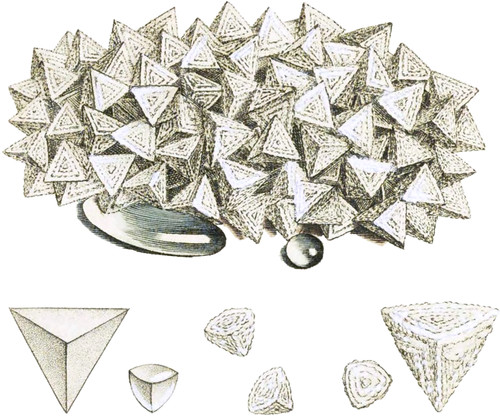 Enlarge
Enlarge
British Mineralogy
Water, Ice or Hail
- Class 1. Combustibles.
- Order 1. Homogeneous.
- Gen. 4. Oxygen.
- Spec. 2. Aqua.
- Div. 1. Crystallized.
- Gen. Char. Permanently Gaseous. In all cases the supporter of Combustion.
- Syn. In combination with Hydrogen.
I have already introduced a subject from the skies, and it is not a little remarkable that it should be necessary to do so again, but to show the insulated crystal of Water I have no other resource. Indeed Water in any form may be deemed more absurd in British Mineralogy than the Meteoric Stone. As it, however, belongs neither to the Vegetable nor Animal Kingdoms of Nature, it must remain to the Mineral one, and this with the more propriety as its ingredients are found dispersed in that division. It has long been known that 85 parts of Oxygen Gas and 15 parts of Hydrogen Gas, combining at the expense of the greater part of their Calor, or the Galvanic or Electric Fluids, &c. form Water, and that this becomes solid, or Ice, at 32° of temperature, being liquid above that point, Hence it is mostly in the latter form that it is best known, such being the more usual temperature of the atmosphere, especially in moderate climates: in winter indeed it is often in the solid state; but on the earth it does not appear to form itself into any distinguishable shapes or crystals, as it is mostly condensed, and dependent on adjacent subjects that are not favourable to equal, or what we call perfect crystallization, and being either in thicker or thinner plates, or shooting into rather undetermined spiculæ.—In the atmosphere, however, it is sometimes surrounded by a more equal medium, so that every side has an equal opportunity to form; and thus we are allowed to see the true shape of the crystal of Water with as much precision as that of an earth or a metal, nay, even more so than Quicksilver, which I believe has not been discovered. As the crystal of Water seems very undetermined by the authors I have examined, it gives me great pleasure in being able to show it. As hail, its crystals are in general rather opaque tetraëdrons, formed of roughish accumulated plates—see the top and right hand geometrical figures—but sometimes in smooth, somewhat rounded transparent tetraëdrons—see the left hand figures. Other forms have been seen; but these are mostly clusters of indistinct granula or spiculæ, or irregular solid masses, or both combined, as in the large hailstones that fell at Menabilly in Cornwall, as observed by my friend Philip Rashleigh, Esq., where the opaque, perhaps minutely crystallized granula were about the size of a pea, and enclosed in flattish irregular masses of ice, half an inch in thickness by an inch and a half or more in length or breadth.—See Mr. King’s Account of the Meteoric Stones. Water is so useful in a fluid state, that neither mankind nor any part of the present mundane system could exist without it. In the solid state it is most quiescent; but at the temperature to which it is most liable to be exposed, in various seasons and climates, it proves a compound ever assisting in the grand scheme of the universe, as the cause of vegetation, beginning that life which is perfected in animals. It makes in most instances the greater bulk of the vegetative body, either disposing the foundation, and conducting the base or root, governed by the unfolding organs of the seed, to descend in due order; or the other parts to grow and ascend, helping the arrangement by a sort of natural union, and guiding the necessary particles to build the wonderful fabric. Since Water has been found to consist of three elements, viz. Hydrogen, Oxygen, and Calor, it has also been found to be soluble in the common air, in various proportions; in which case it is capable of acting either by itself, or in conjunction with the common air ; so that the effects and changes to be wrought upon substances where this fluid comes in contact with them must be innumerable. Thence the many appearances that are otherwise unaccountable may be the more easily comprehended.
Water often contains various substances in solution, such as salts, earths, and even metals. Thus Epsom Salt, or Sulphate of Magnesia, Sulphate and Super-carbonate of Lime, Carbonate of Iron, or Sulphate of Copper, &c. are numerous varieties, and are commonly called Mineral Waters; but as they do not properly constitute different species of Water, one figure is sufficient in this work, unless the varieties of form in the crystals of Snow should warrant more.

